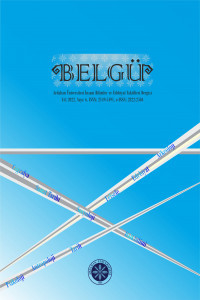Jungçu Arketipler Bağlamında Astro-mitik İkilikler
analitik psikoloji, astroloji, mitoloji, zihin, karşıtların birliği, analytical psychology, astrology, mythology, mind, unity of oppositions
Astro-mythic Dualities in the Context of Jungian Archetypes
analytical psychology, astrology, mythology, mind, unity of oppositions,
___
- Arroyo, S. (1975). Astrology, Psychology, and Four Elements: An Energy Approach to Astrology & Its Use in the Counseling Arts. CRCS Publications.
- Banzhaf, H. & Haebler, A. (1996). Key Words for Astrology. Weiser Books.
- Campbell, J. (2013). Kahramanın Sonsuz Yolculuğu (S. Gürses, Çev.). İthaki Yayınları.
- Case, P. & Phillipson, G. (2004). Astrology, alchemy and retro-organization theory: An astro-genealogical critique of the Myers-Briggs type indicator. Organization, 11(4), 473–495. https://doi.org/10.1177/1350508404044059.
- Dalal, R. (2010). Hiduism An Alphabetical Guide. Penguin Books.
- Eliade, M. (2016). Mephistopheles and the Androgyne Studies in Religious Myth and Symbol (J. M. Cohen, Çev.). Harvill Press.
- Frawley, D. ve Trivedi, P. (2003). The Key of Life: Astrology of the Lunar Nodes. Lotus Press.
- Fromm, E. (1966). Tanrılar Gibi Olacaksınız (B. Leblecioğlu, Çev., 1. basım). Say Yayınları.
- Fromm, E. (1990). Sevginin ve Şiddetin Kaynağı (Y. Salman ve N. İçten, Çev., 5. basım). Payel Yayınevi.
- Fromm, E. (1992). Rüyalar Masallar Mitoslar (A. Arıtan ve K. Ökten, Çev., 2. basım). Arıtan Yayınevi.
- Geçtan, E. (1995). Psikanaliz ve Sonrası (6. basım). Remzi Kitabevi.
- Greene, L. (2018). Jung’s Studies in Astrology Prophecy, Magic, and the Qualities of Time. Routlegde Taylor & Francis Group.
- Grimal, P. (1997). Mitoloji Sözlüğü Yunan ve Roma (S. Tamgüç, Çev., 1. basım). Sosyal Yayınlar.
- Hartner, W. (1938). The Pseudoplanetary Nodes of the Moon’s Orbit in Hindu and Islamic Iconographies. Ars Islamica, 5(2), 112–154. http://www.jstor.org/stable/4520926
- Hesiodos. (2021). Theogonia İşler ve Günler (A. Erhat ve S. Eyüboğlu, Çev., 9. basım). Türkiye İş Bankası Kültür Yayınları.
- İlhan, B. (2022). Astroloji Dersleri (10. basım). Barış İlhan Yayınevi.
- Jacobi, J. (2013). The Psychology of C. G. Jung. Routledge.
- Jung, C. G. (2005). Dört Arketip (S. M. Tura, Çev., 2. basım). Metis Yayınları.
- Jung, C. G. (2006). Analitik Psikoloji (E. Gürol, Çev., 2. basım). Payel Yayınevi.
- Jung, C. G. (2009). İnsan ve Sembolleri (A. N. Babaoğlu, Çev., 4. basım). Okyan Us.
- Jung, C. G. (2014a). The Archetypes and the Collective Unconscious (2nd ed.). Routledge. https://doi.org/10.4324/9781315725642.
- Jung, C. G. (2014b). The Collected Works of CG Jung: Mysterium Coniunctionis (Volume 14): An Inquiry into the Separation and Synthesis of Psychic Opposites in Alchemy. (S. H. Read, M. Fordham, G. Adler, & M. McGuinness (eds.); 2nd ed.). Princeton University Press.
- Jung, C. G. (2016). Analitik Psikoloji Sözlüğü (N. Nirven, Çev., 1. basım). Pinhan Yayıncılık.
- Jung, C. G. (2018). Jung on Astrology (S. Rossi & K. Le Grice (eds.)). Routledge.
- Jung, C. G. (2021). Rüya Analizleri (A. Beyaz, Çev., 2. basım). Pinhan Yayıncılık.
- Jung, C. G. (2014a). The Archetypes and the Collective Unconscious (2nd ed.). Routledge. https://doi.org/10.4324/9781315725642.
- Kahn, C. H. (2001). The Art and Thought of Heraclitus. Cambridge University Press.
- Kavut, S. (2020). Carl Gustav Jung: Kavramları, kuramları ve düşünce yapısı üzeri̇ne bi̇r Iinceleme. Uluslararası Kültürel ve Sosyal Araştırmalar Dergisi (UKSAD), 6(2), 681–695. https://doi.org/10.46442/intjcss.620975
- Moran, B. (2002). Edebiyat Kuramları ve Eleştiri (7. basım). İletişim Yayınları.
- Pannone, S. (2007). The hero’s journey: The search for identity from a psychological, mythological, and astrological perspective. Journal for the Study of Religion, Nature and Culture, 1(2), 220–236. https://doi.org/10.1558/jsrnc.v1i2.220
- Pearson, C. S. (2016). İçimizdeki Kahraman (S. Ayanbaşı, Çev., 2. basım). Akaşa.
- Rogers, C. R. (1963). Toward a Science of the Person. Journal of Humanistic Psychology, 3(2), 72–92. https://doi.org/10.1177/002216786300300208.
- Stevens, A. (2015). Archetype Revisited An Updated Natural History of the Self. https://doi.org/10.4324/9781315740515
- Ukray, M. (2016). Jung Psikolojisi. Yason Yayınları.
- ISSN: 2149-5491
- Yayın Aralığı: Yılda 2 Sayı
- Başlangıç: 2015
- Yayıncı: Ardahan Üniversitesi
Kazak Kültürü, Mitolojisi ve Çağdaş Resim Sanatında Şanırak Motifi
William Blake’in Cennet ile Cehennemin Evliliği Eseri ve Coincidentia Oppositorum
İlyada ve Homeros’un Gözüyle Yunan Dini
Kırgızlarda Dağ Keçilerinin Koruyucu İyesi “Kayberen”
Descartes’ın Mimarlık Metaforlarıyla Açılan Kanallar
Hans Baldung Grien ve Cadı Avı Propaganda Resimleri
İrtiş Nehri İsmi ve Ortaya Çıkışıyla İlgili Efsaneler
Jungçu Arketipler Bağlamında Astro-mitik İkilikler
Antalya/Gündoğmuş Yöresindeki Doğum Âdetlerinde Mitolojik Unsurlar
